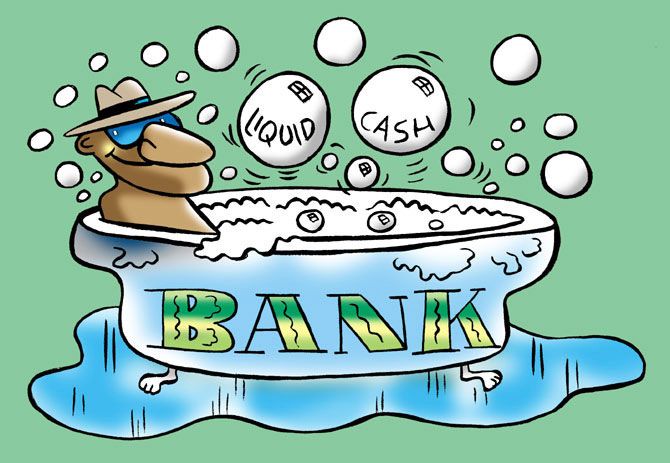 | « Back to article | Print this article |
Concerned over inflationary pressures in the economy, the Reserve Bank of India (RBI) is bringing down surplus liquidity in the system rapidly.

It has fallen to pre-Covid levels and almost 2 per cent of banks’ net demand and time liabilities (NDTL).
NDTL shows the difference between the sum of demand and time liabilities (deposits) of a bank (with the public or the other bank) and the deposits in the form of assets held by the other bank.
This sudden withdrawal of liquidity at a rapid pace has surprised banks since the central bank had earlier said it would bring down surplus liquidity in a multi-year time frame.
“The increase in the cash reserve ratio (CRR), which came into effect on May 21, has sapped Rs 87,000 crore from the system.
"In addition, the RBI is selling dollars and sucking out rupee liquidity, resulting in excess liquidity coming down rapidly,” said a treasury head of a public sector bank.
According to the RBI data, the daily liquidity absorption from the banking system was Rs 2.96 trillion on Monday, down from Rs 3.22 trillion on May 20 – a day before the CRR hike came into effect.
About a month back, the liquidity absorption from the system was over Rs 5 trillion.
In a surprise move in early May, the RBI increased the repo rate by 40 basis points (bps) to 4.4 per cent.
CRR was also hiked by 50 bps to 4.5 per cent.
Until early May, the liquidity in the banking system had been descending gradually.
The daily liquidity absorption under the liquidity adjustment facility averaged Rs 6.8 trillion in the second week of April through May 12, moderating from Rs 7.5 trillion during the second fortnight of March through mid-April.
“Since the beginning of April, the RBI has hiked the effective policy rate (i.e., the standing deposit facility) by 80 bps. And the consensus is to raise it further by another 75 bps over the next two policies.
"Further, the liquidity surplus is already down to less than 2 per cent of NDTL in the past few days, same as in the pre-Covid period (late 2019) and compared with 4.5 per cent of NDTL in early April,” observed Motilal Oswal Securities in a report.
“All these suggest that if the consensus is to be believed, all rate cuts in the past two years will be reversed in just about four months; further, the excess liquidity surplus is already back to pre-Covid levels.
"We believe that such steep monetary tightening is unwarranted,” added the report.
The data from Bloomberg also showed banking system liquidity falling fast in the past month. Excess liquidity in the banking system was Rs 3.72 trillion on Monday, down from Rs 6.5 trillion a month earlier.
Liquidity surplus reached its zenith on September 9, 2021, hitting Rs 9.96 trillion.
Bankers said the central bank may be moving towards reducing the liquidity surplus to 1.5 per cent of NDTL.
The Report on Currency and Finance released by the RBI last month said that surplus liquidity over 1.52 per cent of NDTL could be inflationary.
The report said that a 1 percentage point exogenous increase in surplus liquidity above the threshold could push up inflation by 60 bps on average in a year.
Due to a fall in surplus liquidity, banks have been putting smaller amounts into the variable rate reverse repo auction of the RBI – a tool deployed by the central bank to aspirate excess liquidity.
Bankers point out that a lower government spending is another reason for the fall in surplus liquidity.
“Once the government starts spending, liquidity will come back.
"It had dwindled due to factors, including the month-end goods and services tax payments, apart from hike in CRR,” said Devendra Dash, head of asset liability management, AU Small Finance Bank.
“The RBI had said that surplus liquidity will drop.
"But it is still a surplus. For credit reasons, liquidity is there,” said Dash.
A section of the market sees further liquidity tightening measures from the RBI in the June review of the monetary policy. Barclays India said the RBI is expected to increase CRR further by 50 bps - this could come into effect end-June or early-July.